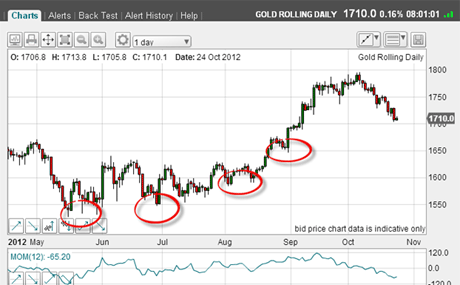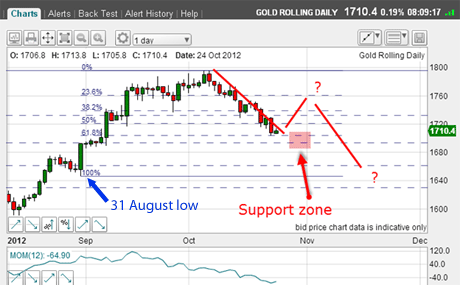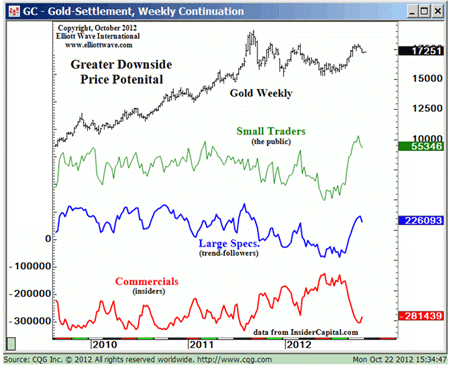The latest gold dilemma
Gold has presented John C Burford with a problem - albeit one most traders would love to have.
After very large declines this week in the Dow, the trades I have recently described in gold and to a lesser extent the euro are going to plan. That means I have few new lessons to relate today!It is a question of keeping one eye on likely support zones where rallies can be started and short-term profits can be banked.
But gold is presenting me with a little headache, albeit one that most traders would like.
The problem I have is this: where are the best Fibonacci pivot points I can use so that I have a clear idea of support zones?
MoneyWeek
Subscribe to MoneyWeek today and get your first six magazine issues absolutely FREE

Sign up to Money Morning
Don't miss the latest investment and personal finances news, market analysis, plus money-saving tips with our free twice-daily newsletter
Don't miss the latest investment and personal finances news, market analysis, plus money-saving tips with our free twice-daily newsletter
In particular, which significant low can I use for the low pivot point?The top pivot point has already been presented the 5 October $1,796 high.
Here is the daily chart:

(Click on the chart for a larger version)
I have circled some possibilities there are at least eight candidates! First let's go to the most recent (far right-hand circle) after all, this is the first low put in following the upside breakout of the summer's trading range.
And we must use the $1,530 low (far left hand circle) for another Fibonacci set, as that was a true low:

(Click on the chart for a larger version)
I have combined both Fibonacci levels on the same chart.
Using the 31 August low Fibonacci, the current market has hit the 62% retrace. Hmm.
And using the $1,530 low Fibonacci, the 38% retrace lies just below.
That means there is significant support at around current levels, or slightly below (marked by pink bar).
If so, we should see a bounce soon. I have put a likely path on the chart by my red bars.
Now, if this occurs, we could have an A-B-C (corrective) pattern, or alternatively another five-wave sequence. Time will tell.
Of course, we could see a further plunge through this support, as weak longs continue to abandon ship.
What time frame are we working on?
In terms of tactics, that would depend on whether you are trading short-term or long-term.
If short term, you would be looking to take profits ahead of the likely bounce.Since the entry was at the $1,775 area that would be a very tasty profit.
If trading long-term, you would be looking to add to short positions as the bounce (hopefully) turns around.
This brings up an interesting point.If someone asks me if I am bullish, bearish or neutral on gold, I would ask "Which time-frame are you referring to?"
I might say that for today I am slightly leaning towards a bull stance. But over a week's time-frame I would say I am neutral to bearish. And over a month I would say I am bearish.
Why I'm cautious of the bullish market mood
OK, I have repeatedly stressed how distorted the trader sentiment and Commitmentof Traders(COT) figures have been recently. Let's see what they say.

(chart courtesy elliottwave.com)
The three coloured lines are the futures holdings from the COT data of the various trader groups.
Note the huge increase in longs by the Large Specs (hedge funds and exchange-traded funds(ETFs)) and the public since the upward break-out in late August. All the while, the trade have been selling to them.
With near-record long positions by the Specs persisting, the downside potential is huge. A bottom will only be reached when gold is considered washed-out with greatly reduced long positions by the Specs.
I do scan the blogosphere for the mood of the market, and have recently noted an increase in very bullish forecasts ranging from $2,000, $2,500.I have even seen$5,000!
Polled sentiment readings have also been at record bullishness recently.
That evidence was crucial in my forecast for a top. Remember, major turns are always accompanied by sentiment extremes.
Trader tip: Do not get caught up in the feverish excitement as markets rally to a top.Learn to switch your thinking around and ask: "If every man and his dog are buying, do I want to be in that group?"
As we have seen in the past three weeks, a small dip off the $1,796 top (normal profit-taking) has turned into a much more significant event with the market yesterday $90 off its high.
Now, many will be eyeing this dip as an opportunity to buy. That is perfectly understandable.Many have seen gold soar and have either not been on board, or have decided they do not hold enough. This seems a heaven-sent chance to correct matters.
And that is what makes the markets!
If you're a new reader, or need a reminder about some of the methods I refer to in my trades, then do have a look at my introductory videos:
The essentials of tramline trading
An introduction to Elliott wave theory
Advanced trading with Elliott waves
Don't miss my next trading insight. To receive all my spread betting blog posts by email, as soon as I've written them, just sign up here . If you have any queries regarding MoneyWeek Trader, please contact us here.
Get the latest financial news, insights and expert analysis from our award-winning MoneyWeek team, to help you understand what really matters when it comes to your finances.
John is is a British-born lapsed PhD physicist, who previously worked for Nasa on the Mars exploration team. He is a former commodity trading advisor with the US Commodities Futures Trading Commission, and worked in a boutique futures house in California in the 1980s.
He was a partner in one of the first futures newsletter advisory services, based in Washington DC, specialising in pork bellies and currencies. John is primarily a chart-reading trader, having cut his trading teeth in the days before PCs.
As well as his work in the financial world, he has launched, run and sold several 'real' businesses producing 'real' products.
-
 Metals and AI power emerging markets
Metals and AI power emerging marketsThis year’s big emerging market winners have tended to offer exposure to one of 2025’s two winning trends – AI-focused tech and the global metals rally
-
 8 of the best houses for sale with beautiful fireplaces
8 of the best houses for sale with beautiful fireplacesThe best houses for sale with beautiful fireplaces – from a 15th-century cottage in Kent to a 17th-century palazzo in Oxfordshire